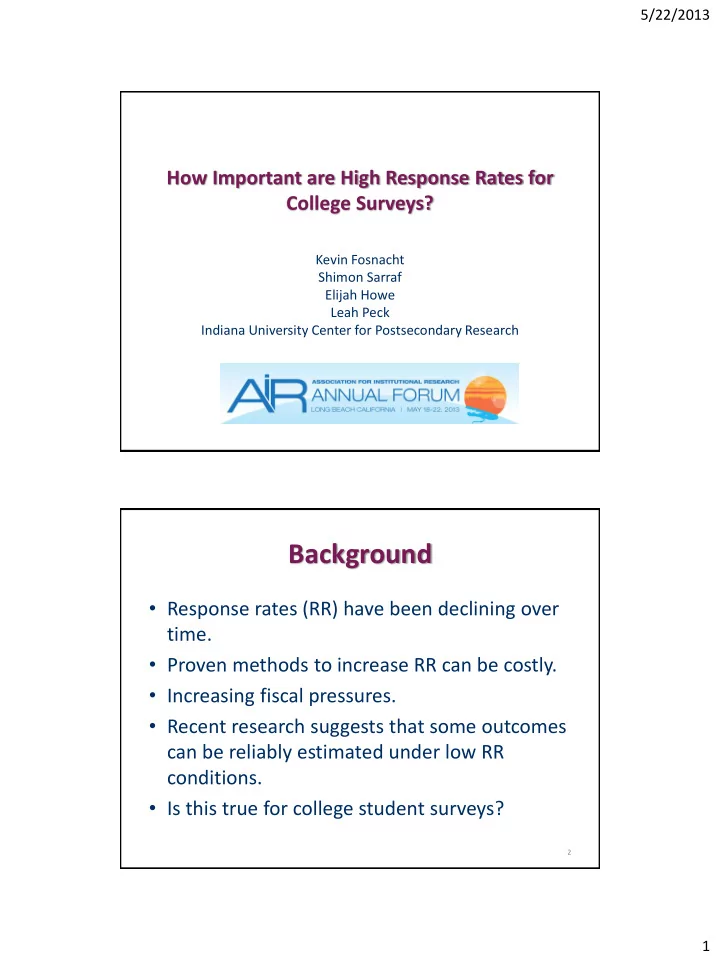

5/22/2013 How Important are High Response Rates for College Surveys? Kevin Fosnacht Shimon Sarraf Elijah Howe Leah Peck Indiana University Center for Postsecondary Research Background • Response rates (RR) have been declining over time. • Proven methods to increase RR can be costly. • Increasing fiscal pressures. • Recent research suggests that some outcomes can be reliably estimated under low RR conditions. • Is this true for college student surveys? 2 1
5/22/2013 Theory Nonresponse Difference Nonresponse Nonresponse Bias between Rate Effect (difference sample and between population responders and statistics nonresponders) • Nonresponse bias is generally viewed as a function of nonresponse rate and nonresponse effect (Keeter, et. al., 2000). 3 Theory (cont.) • Leverage-saliency theory -Survey features -Prominence in request to participate 4 2
5/22/2013 Level of Effort • Response rate and nonresponse bias are somewhat artificial and arbitrary because they are dependent on researcher decisions, or level of effort (Olson, 2006). – Example: supermarket survey versus U.S. Census 5 Level of Effort (cont.) Curtin, Presser, & Singer, 2000 • Level of effort study on Index of Consumer Sentiment. • Explores impact of low response rates when no reminder attempts used. • Conclusion: preliminary estimates close to final estimates 6 3
5/22/2013 Level of Effort (cont.) Hutchison, Tollefson, & Wigington, 1987 • Only level of effort study focusing on higher education. • 600 first-year students enrolled in different classes, assigned to different survey samples. • No meaningful differences in students’ perceptions of academic environment when comparing estimates from administrations with RR’s of 35 and 100 percent. 7 Hypothetical Level of Effort Analysis 100 Simulated Estimate Final Estimate 80 85 80 80 79 75 70 60 Score 40 20 0 5% 10% 15% 20% 25% 70% Response Rate 8 4
5/22/2013 Research Questions 1. Do simulated low response rate survey estimates about college student engagement provide reliable information based on comparisons to actual high response rate estimates? 2. Do simulated low respondent count estimates provide reliable information based on comparisons to full sample estimates? 3. Do these results vary by institution sample size? 9 Data Sample • National Survey of Student Engagement (NSSE) – 2010, 2011 and 2012 administrations (online survey only) – Only ≥ 50% response rate administrations used – 555 first-year and senior administrations from 307 bachelor’s degree -granting institutions; 110K students • NSSE Benchmarks – Level of Academic Challenge – Active & Collaborative Learning – Student-Faculty Interaction – Supportive Campus Environment 10 5
5/22/2013 Methods • Level of effort analysis: recalculated survey estimates under alternative RR of 5, 10, 15, 20, 25, 30, and 35% • Correlated recalculated estimates with full sample estimate – all administrations and by 4 sample size categories • Analysis repeated using respondent counts of 10, 25, 50, 75, 100, 150, and 200 • .90 correlation indicates strong reliability 11 Methods (cont.) Administration Sample Size Categories Very Small 20 ≤ N < 250 n = 293 Small 250 ≤ N < 500 n = 168 Medium 500 ≤ N < 1,000 n = 74 Large N ≥ 1,000 n = 20 N = Total number sampled n = # of individual administrations 12 6
5/22/2013 Results: Response Rates 13 5% Level of Effort: Level of Academic Challenge Simulated Estimate r = .64 Actual Estimate 14 7
5/22/2013 15% Level of Effort: Level of Academic Challenge Simulated Estimate r = .86 Actual Estimate 15 25% Level of Effort: Level of Academic Challenge Simulated Estimate r = .93 Actual Estimate 16 8
5/22/2013 5% Level of Effort: Academic Challenge Differences between Very Small & Large Administrations Very Small Administrations Large Administrations Simulated Estimate r = .61 r = .94 Actual Estimate 17 Results: Respondent Count 18 9
5/22/2013 n=10 Level of Effort: Academic Challenge Simulated Estimate r = .68 Actual Estimate 19 n=25 Level of Effort: Academic Challenge Simulated Estimate r = .87 Actual Estimate 20 10
5/22/2013 n=50 Level of Effort: Academic Challenge Simulated Estimate r = .94 Actual Estimate 21 n=25 Level of Effort: Academic Challenge Differences between Very Small & Large Administrations Very Small Administrations Large Administrations Simulated Estimate r = .90 r = .76 Actual Estimate 22 11
5/22/2013 Reliability by Size & N Simulated Respondent Count Level of Academic 10 25 50 75 Challenge All administrations .94 .96 .68 .87 Very small .90 .96 .98 .74 Small .83 .92 .95 .58 Medium .91 .57 .74 .88 Large .92 .94 .76 .55 23 Summary Findings (using all 4 measures) Q1: Do simulated low response rate survey estimates about college student engagement provide reliable information based on comparisons to actual high response rate estimates? Yes, RR between 5% and 25% appear to provide reliable estimates, depending on sample size and engagement measure. 24 12
5/22/2013 Summary Findings (cont.) Q2: Do simulated low respondent count estimates provide reliable information based on comparisons to full sample estimates? Yes, between 25 and 75 respondents appear to provide reliable institution-level estimates. 25 Summary Findings (cont.) Q3: Do these results vary by institution sample size? Yes, administration sample size has a meaningful impact on the results of this study. For reliable estimates: • Larger institutions need more respondents • Smaller institutions need higher response rates 26 13
5/22/2013 Implications • Institution-level estimates of undergraduate behavior can be reliable under low RR and N conditions. • Reliability of NSSE measures is more strongly related to N than RR. • Depending upon survey goals and needs for sub-group analysis, random sample may be an option for some projects. (NSSE encourages collecting enough data for sub-group analysis!) • Other measures of data quality (item missing, duration, validity, etc.) deserve more attention. 27 Conclusion • Future research… – institutional outliers – statistical tests – other higher education surveys • Once an administration reaches threshold, whether it be RR or N, more effort at collecting additional respondents will not likely yield much change in institutional estimates. 28 14
5/22/2013 Thank you!!! Paper available at: http://nsse.iub.edu/html/pubs.cfm ssarraf@indiana.edu echowe@indiana.edu 15
Recommend
More recommend